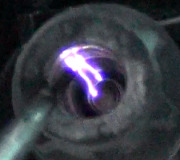Saturday, February 27th, 2010 AT 11:06 AM
What would cause no spark? I drove the truck home last Friday and parked the vehicle. Monday morning the truk turned over and would not start. I cheked and charged the battery. It tested good. First, I pulled one park plug attached it to the ignition wire turned over the engine. Next, I held the spark plug next to an engine mount and had a friend turn nthe key. I saw no spark at all. Before doing this I hecked all wire connections to make sure there was no loose wires. Any advise would be greatl



